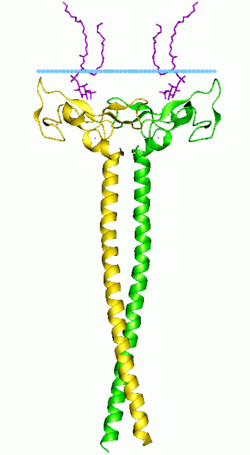EEA1
| EEA1 | |||||||||||||||||||||||||
|---|---|---|---|---|---|---|---|---|---|---|---|---|---|---|---|---|---|---|---|---|---|---|---|---|---|
 | |||||||||||||||||||||||||
| |||||||||||||||||||||||||
| Identifiers | |||||||||||||||||||||||||
| Aliases | EEA1, MST105, MSTP105, ZFYVE2, early endosome antigen 1 | ||||||||||||||||||||||||
| External IDs | OMIM: 605070 MGI: 2442192 HomoloGene: 37822 GeneCards: EEA1 | ||||||||||||||||||||||||
| |||||||||||||||||||||||||
| |||||||||||||||||||||||||
| |||||||||||||||||||||||||
| Orthologs | |||||||||||||||||||||||||
| Species | Human | Mouse | |||||||||||||||||||||||
| Entrez |
|
| |||||||||||||||||||||||
| Ensembl |
|
| |||||||||||||||||||||||
| UniProt |
|
| |||||||||||||||||||||||
| RefSeq (mRNA) |
|
| |||||||||||||||||||||||
| RefSeq (protein) |
|
| |||||||||||||||||||||||
| Location (UCSC) | Chr 12: 92.77 – 92.93 Mb | Chr 10: 95.94 – 96.05 Mb | |||||||||||||||||||||||
PubMed search | [3] | [4] | |||||||||||||||||||||||
| Wikidata | |||||||||||||||||||||||||
| |||||||||||||||||||||||||
The gene EEA1 encodes for the 1400 amino acid protein, Early Endosome Antigen 1.
EEA1 localizes exclusively to early endosomes and has an important role in endosomal trafficking. EEA1 binds directly to the phospholipid phosphatidylinositol 3-phosphate through its C-terminal FYVE domain and forms a homodimer through a coiled coil. EEA1 acts as a tethering molecule that couples vesicle docking with SNAREs such as N-ethylmaleimide sensitive fusion protein, bringing the endosomes physically closer and ultimately resulting in the fusion and delivery of endosomal cargo.
Contents
1 Function
2 Involvement in pathogenesis
3 See also
4 References
5 External links
Function
EEA1 is a RAB5A effector protein which binds via an N-terminal zinc finger domain and is required for fusion of early and late endosomes and for sorting at the early endosome level.[5][6]
Involvement in pathogenesis
Due to the proteins importance in vesicular trafficking, a number of intracellular bacteria prevent EEA1 recruitment to the vacuole. Mycobacterium tuberculosis is known to inhibit the recruitment of EEA1 to the phagosomal membrane through CamKII.[7]Legionella pneumophila also prevents EEA1 recruitment through a currently unknown mechanism.[8] The related pathogen Legionella longbeachae recruits EEA1 and appears to replicate within a modified early endosome.[9]
See also
- endosome
- Phosphatidylinositol 3-phosphate
- FYVE domain
References
^ abc GRCh38: Ensembl release 89: ENSG00000102189 - Ensembl, May 2017
^ abc GRCm38: Ensembl release 89: ENSMUSG00000036499 - Ensembl, May 2017
^ "Human PubMed Reference:"..mw-parser-output cite.citation{font-style:inherit}.mw-parser-output q{quotes:"""""""'""'"}.mw-parser-output code.cs1-code{color:inherit;background:inherit;border:inherit;padding:inherit}.mw-parser-output .cs1-lock-free a{background:url("//upload.wikimedia.org/wikipedia/commons/thumb/6/65/Lock-green.svg/9px-Lock-green.svg.png")no-repeat;background-position:right .1em center}.mw-parser-output .cs1-lock-limited a,.mw-parser-output .cs1-lock-registration a{background:url("//upload.wikimedia.org/wikipedia/commons/thumb/d/d6/Lock-gray-alt-2.svg/9px-Lock-gray-alt-2.svg.png")no-repeat;background-position:right .1em center}.mw-parser-output .cs1-lock-subscription a{background:url("//upload.wikimedia.org/wikipedia/commons/thumb/a/aa/Lock-red-alt-2.svg/9px-Lock-red-alt-2.svg.png")no-repeat;background-position:right .1em center}.mw-parser-output .cs1-subscription,.mw-parser-output .cs1-registration{color:#555}.mw-parser-output .cs1-subscription span,.mw-parser-output .cs1-registration span{border-bottom:1px dotted;cursor:help}.mw-parser-output .cs1-hidden-error{display:none;font-size:100%}.mw-parser-output .cs1-visible-error{font-size:100%}.mw-parser-output .cs1-subscription,.mw-parser-output .cs1-registration,.mw-parser-output .cs1-format{font-size:95%}.mw-parser-output .cs1-kern-left,.mw-parser-output .cs1-kern-wl-left{padding-left:0.2em}.mw-parser-output .cs1-kern-right,.mw-parser-output .cs1-kern-wl-right{padding-right:0.2em}
^ "Mouse PubMed Reference:".
^ Mishra A, Eathiraj S, Corvera S, Lambright DG (Jun 2010). "Structural basis for Rab GTPase recognition and endosome tethering by the C2H2 zinc finger of Early Endosomal Autoantigen 1 (EEA1)". Proceedings of the National Academy of Sciences of the United States of America. 107 (24): 10866–71. doi:10.1073/pnas.1000843107. PMC 2890723. PMID 20534488.
^ Barysch SV, Aggarwal S, Jahn R, Rizzoli SO (Jun 2009). "Sorting in early endosomes reveals connections to docking- and fusion-associated factors" (PDF). Proceedings of the National Academy of Sciences of the United States of America. 106 (24): 9697–702. doi:10.1073/pnas.0901444106. PMC 2691687. PMID 19487677.
^ Malik ZA, Thompson CR, Hashimi S, Porter B, Iyer SS, Kusner DJ (Mar 2003). "Cutting edge: Mycobacterium tuberculosis blocks Ca2+ signaling and phagosome maturation in human macrophages via specific inhibition of sphingosine kinase". Journal of Immunology. 170 (6): 2811–5. doi:10.4049/jimmunol.170.6.2811. PMID 12626530.
^ Urwyler S, Nyfeler Y, Ragaz C, Lee H, Mueller LN, Aebersold R, Hilbi H (Jan 2009). "Proteome analysis of Legionella vacuoles purified by magnetic immunoseparation reveals secretory and endosomal GTPases". Traffic. 10 (1): 76–87. doi:10.1111/j.1600-0854.2008.00851.x. PMID 18980612.
^ Asare R, Abu Kwaik Y (Jun 2007). "Early trafficking and intracellular replication of Legionella longbeachaea within an ER-derived late endosome-like phagosome". Cellular Microbiology. 9 (6): 1571–87. doi:10.1111/j.1462-5822.2007.00894.x. PMID 17309675.
External links
early+endosome+antigen+1 at the US National Library of Medicine Medical Subject Headings (MeSH)
This biochemistry article is a stub. You can help Wikipedia by expanding it. |



